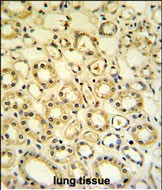H6PD Antibody (C-term)
Affinity Purified Rabbit Polyclonal Antibody (Pab)
- 产品详情
- 文献引用 : 1
- 实验流程
- 背景知识
Application
| WB, IHC-P, E |
|---|---|
| Primary Accession | O95479 |
| Other Accession | Q8CFX1 |
| Reactivity | Human, Mouse |
| Host | Rabbit |
| Clonality | Polyclonal |
| Isotype | Rabbit IgG |
| Calculated MW | 88893 Da |
| Antigen Region | 743-769 aa |
| Gene ID | 9563 |
|---|---|
| Other Names | GDH/6PGL endoplasmic bifunctional protein, Glucose 1-dehydrogenase, Hexose-6-phosphate dehydrogenase, 6-phosphogluconolactonase, 6PGL, H6PD, GDH |
| Target/Specificity | This H6PD antibody is generated from rabbits immunized with a KLH conjugated synthetic peptide between 743-769 amino acids from the C-terminal region of human H6PD. |
| Dilution | WB~~1:1000 IHC-P~~1:100~500 E~~Use at an assay dependent concentration. |
| Format | Purified polyclonal antibody supplied in PBS with 0.09% (W/V) sodium azide. This antibody is purified through a protein A column, followed by peptide affinity purification. |
| Storage | Maintain refrigerated at 2-8°C for up to 2 weeks. For long term storage store at -20°C in small aliquots to prevent freeze-thaw cycles. |
| Precautions | H6PD Antibody (C-term) is for research use only and not for use in diagnostic or therapeutic procedures. |
| Name | H6PD (HGNC:4795) |
|---|---|
| Synonyms | GDH |
| Function | Bifunctional enzyme localized in the lumen of the endoplasmic reticulum that catalyzes the first two steps of the oxidative branch of the pentose phosphate pathway/shunt, an alternative to glycolysis and a major source of reducing power and metabolic intermediates for biosynthetic processes (By similarity). Has a hexose-6-phosphate dehydrogenase activity, with broad substrate specificity compared to glucose-6-phosphate 1-dehydrogenase/G6PD, and catalyzes the first step of the pentose phosphate pathway (PubMed:12858176, PubMed:18628520, PubMed:23132696). In addition, acts as a 6-phosphogluconolactonase and catalyzes the second step of the pentose phosphate pathway (By similarity). May have a dehydrogenase activity for alternative substrates including glucosamine 6-phosphate and glucose 6-sulfate (By similarity). The main function of this enzyme is to provide reducing equivalents such as NADPH to maintain the adequate levels of reductive cofactors in the oxidizing environment of the endoplasmic reticulum (PubMed:12858176, PubMed:18628520, PubMed:23132696). By producing NADPH that is needed by reductases of the lumen of the endoplasmic reticulum like corticosteroid 11-beta-dehydrogenase isozyme 1/HSD11B1, indirectly regulates their activity (PubMed:18628520). |
| Cellular Location | Endoplasmic reticulum lumen |
| Tissue Location | Present in most tissues examined, strongest in liver. |
For Research Use Only. Not For Use In Diagnostic Procedures.

Provided below are standard protocols that you may find useful for product applications.
BACKGROUND
H6PD is 2 forms of glucose-6-phosphate dehydrogenase. G form is X-linked and H form, encoded by this gene, is autosomally linked. This H form shows activity with other hexose-6-phosphates, especially galactose-6-phosphate, whereas the G form is specific for glucose-6-phosphate. Both forms are present in most tissues, but H form is not found in red cells.
REFERENCES
Balazs, Z., et al. Mol. Cell. Endocrinol. 301 (1-2), 117-122 (2009) Zhang, Y.L., et al. Arch. Biochem. Biophys. 483(1):45-54(2009) Uckaya, G., et al. Diabetes Res. Clin. Pract. 82 SUPPL 2, S135-S140 (2008)
终于等到您。ABCEPTA(百远生物)抗体产品。
点击下方“我要评价 ”按钮提交您的反馈信息,您的反馈和评价是我们最宝贵的财富之一,
我们将在1-3个工作日内处理您的反馈信息。
如有疑问,联系:0512-88856768 tech-china@abcepta.com.






















 癌症的基本特征包括细胞增殖、血管生成、迁移、凋亡逃避机制和细胞永生等。找到癌症发生过程中这些通路的关键标记物和对应的抗体用于检测至关重要。
癌症的基本特征包括细胞增殖、血管生成、迁移、凋亡逃避机制和细胞永生等。找到癌症发生过程中这些通路的关键标记物和对应的抗体用于检测至关重要。 为您推荐一个泛素化位点预测神器——泛素化分析工具,可以为您的蛋白的泛素化位点作出预测和评分。
为您推荐一个泛素化位点预测神器——泛素化分析工具,可以为您的蛋白的泛素化位点作出预测和评分。 细胞自噬受体图形绘图工具为你的蛋白的细胞受体结合位点作出预测和评分,识别结合到自噬通路中的蛋白是非常重要的,便于让我们理解自噬在正常生理、病理过程中的作用,如发育、细胞分化、神经退化性疾病、压力条件下、感染和癌症。
细胞自噬受体图形绘图工具为你的蛋白的细胞受体结合位点作出预测和评分,识别结合到自噬通路中的蛋白是非常重要的,便于让我们理解自噬在正常生理、病理过程中的作用,如发育、细胞分化、神经退化性疾病、压力条件下、感染和癌症。







